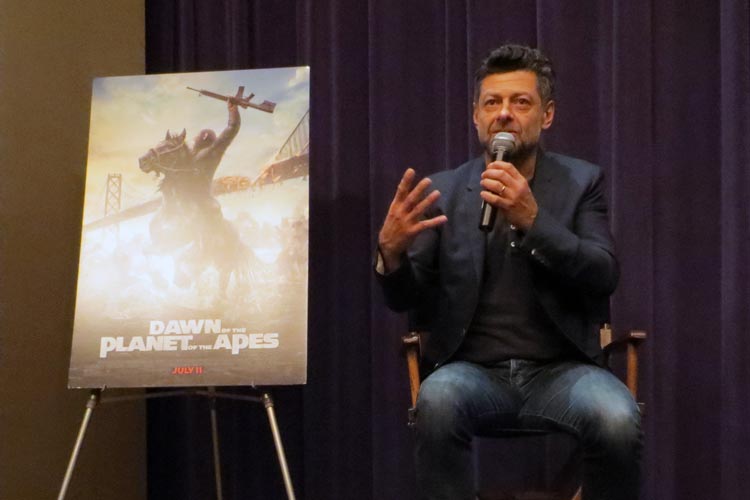The following questions and answers are excerpted from a conversation that followed the NBR screening of Dawn of the Planet of the Apes.
Can you talk about the evolution of Caesar’s character from Rise of the Planet of the Apes to this film?
The approach to the role for me has always been to think of Caesar as having a human mind within an ape’s body. And physically playing him in the first movie, he was much more chimp-like in his movements. But gradually his whole body begins to change and he becomes more bipedal. This early version of Caesar was based on a real chimpanzee called Oliver who was, for a time in the 1970’s, believed to be a living example of the missing link! Sort of a progeny of man and ape. This was because he was almost entirely bipedal—he’d walk on two legs into a room and sit just as we’re sitting now. And his facial expressions were also incredibly human. And then the journey of Caesar in this movie was very much about an ape that can empathize with both his own tribe and also the tribe of humans. And that kind of conflict, the internal conflict of not wanting to throw away all of the things he learned from humanity while also protecting his own tribe, meant that the journey continued for me in an emotional sense with Caesar as well as the physical.
“I’ve always believed that acting is a privilege.”
How has the performance capture technology changed since you started working with it, and how have those changes impacted your performance?
Every single film since Lord of the Rings has been a progression for the technology. But not just the technology—after all, the cameras are cameras (there have always been cameras capturing our performances). It happens to be in 360 degrees, and instead of wearing traditional costumes we’re wearing these gray suits, and the suits are covered with special sensors and cameras to capture our expressions. So yes, all of that improves, the fidelity improves, the sensitivity to every single nuance of expression improves. But it really has more to do with the people. It has more to do with the artistry, because there are two main elements to this process: One is the performance, which takes place on set, as any traditional film might. Once the director gets the performances he wants, he edits the film just as he would any other film—totally without the visual effects being present. So he’s editing purely based on the performances of the actors (whether they’re playing apes or humans), based on whether he finds the performances moving, emotionally impactful, and so on. And then there’s the second element, which is not as traditional, that comes in in the work that Weta Digital [the post facility that did FX for this film] does. They take the performances and shots the director has selected and layer the effects onto those frames in order to build the ape characters. This is very different than the process we used for the Lord of the Rings films with Gollum. In those films, I had to do the scene once with the other actors, and then again – alone, in isolation – on a motion-capture stage. And at that time, the technology wasn’t capturing facial expressions; it could only do body movement. Gollum’s facial expressions were derived from animators watching and manually matching my performance, but not directly from my performance. King Kong was the first film to use direct facial performance capture. It was a big breakthrough when we were able to take the facial performance capture directly to the set, which is what we’ve done for this film.
More broadly, can you discuss your discovery process for a character? You’ve done such a remarkable job throughout your career of making exotic characters accessible and emotionally impactful for the audience.
I’ve always found as an actor that I’m able to say something best through a character that’s actually farther from myself. Which is why I really love this technology. Because philosophically as an actor, to be able to play something where it doesn’t matter what size you are, what shape you are, what the color of your skin is, what sex you are… as long as you can embody that character, as long as you can use your acting chops to somehow connect with that character and bring it to life, then the technology has enabled you to say something about the human condition with a level of clarity which is, interestingly, sometimes harder to achieve when playing a character closer to who you really are. And for me, I find that type of clarity in acting fascinating. I’ve always believed that acting is a privilege. I suppose it goes back to something the very first director I worked with said to me. He said, “you’re so privileged to be an actor, because it’s a service that you do: you go out and research and build a character, and bring it back to an audience and share it, much like a shaman might have done thousands of years ago around a campfire.” And if I’m going to do that, I’ve got to know what I’m saying, and really understand it.

